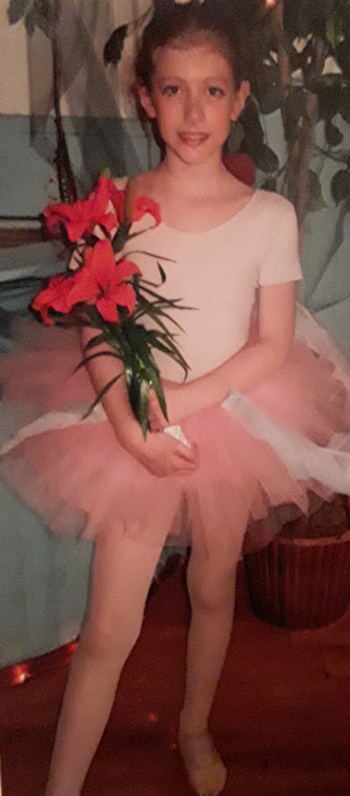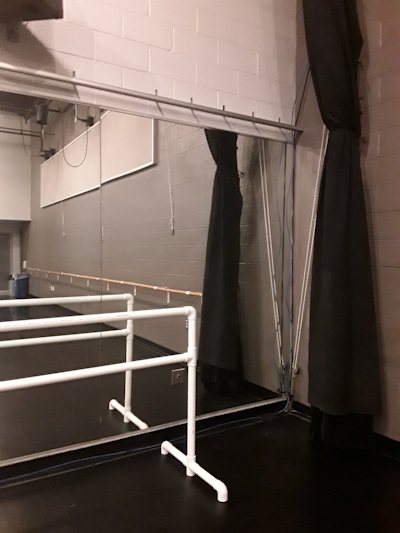By Ashling Wahner
The arts can be a profoundly beneficial means of self-expression, giving voice to those who feel otherwise unable to communicate their thoughts, emotions, and experiences. In order to empower individuals in artistic environments, it is important to create spaces in which individuals feel comfortable, acknowledged, and valued.
I began dancing at the age of five and have found a home in the dance studio ever since. Throughout my childhood and up until this present moment both as a college student and a dance teacher, I have been fortunate to receive a great deal of positivity, support, and mentorship from fellow students and other dance teachers. These welcoming environments have allowed me to feel capable and confident in my ability as a dancer.
In my own experience as a dancer, I have felt the importance of open, authentic dialogue within the studio. Some of my most positive learning experiences have been ones where I have been able to connect with my dance teachers, sharing my vulnerabilities and challenges. Building strong relationships and rapport with my instructors has allowed me to enhance my skillset in ways that maximize my own performance. My learning experiences have fueled my teaching philosophy, which at its core is rooted in creating supportive spaces where students feel safe to express themselves.
Despite my favorable experiences, the dance world can also be strict and competitive. Dance classes often operate with authoritarian practices where the teacher is an unquestioned expert. This can lead to student needs going unnoticed and students having little to no say in their own experiences. Warm, supportive studio settings are often bypassed in favor of traditional training models where the teacher lectures as the main form of instruction. These teaching methods can be limiting, providing marginal space for creative agency or expressing concerns.

Reflecting on my own education, I know that the dance world can be harsh. Along with my peers, I have felt the pressures of negative class experiences and unhealthy social influences. I know many dancers who have experienced upsetting studio settings, often to the detriment of their mental health. Despite these pressures, dance has been an outlet that has brought me immense joy.
Having seen traditional aspects of dance culture that are limiting and unhealthy, I want to ensure these elements are recognized and are no longer perpetuated. Dance has been an integral and positive presence in my life, and I want others to have similarly affirmative experiences. By sharing my experience, I hope to inspire conversations surrounding healthy studio environments that empower others to learn this beautiful art form while listening to and taking care of themselves.
The visible and invisible elements of dance
Dance is often thought of as a predominantly physical activity. Dancers move their bodies in rhythmic patterns creating an artistic spectacle that may tell a story or express emotion. Concurrently engaged in exploration, the body’s capabilities on full display. The emphasis on visually stimulating beauty, athleticism, and physicality is what initially drew me to don a tiny pink tutu in kindergarten. These same qualities are what continue to fuel my love of dance to this day. As exquisite an art form as dance is, when viewed solely as a physical activity, there is a risk of diminishing the significance of its emotional aspects.
Bodily injuries in dancers are quite common and might consist of broken bones, sprained ligaments, and concussions. When dancers get hurt, these visible injuries are noted and medically treated without question. This is not always the case when it comes to mental health. In a discipline so focused on the outwardly visual, mental health ailments are not as noticeable, despite that the issues might be triggered and exacerbated by the environment of dance itself.
In the dance field, physical trauma is common, and acknowledged, but it is just as important to consider how emotional trauma may affect dancers in less obvious ways. While identifying a sprained ankle is a straightforward diagnosis, it can be much more difficult to recognize a dancer who is experiencing depression or anxiety. The challenge of noticing internal pain can result in mental health issues being rendered invisible within the dance community.
The complicated role of the mirror
The mirror is a prevailing focal point of any given dance class. Students are often asked to face their own reflections for hours at a time in order to see themselves and evaluate their performances. The mirror can be a useful tool for students when it comes to correcting alignment and following demonstrations. It can also be fun and encouraging for students to see what they look like while exploring new movements. However, constant use of the mirror in dance studios has created a culture deeply based in outward appearance, self-judgement, and comparison to others.
An image-focused environment where dancers perpetually see and evaluate their own reflections may reinforce insecurities. In a recent study, college students who danced in front of a mirror for one semester developed negative attitudes about their physical appearances, whereas students who spent the semester dancing without mirrors were more likely to have positive perceptions about their bodies. Ongoing criticism about appearance can lead to distorted body image issues, subtle or overt body-shaming, and other psychological concerns.

Common Mental Health Issues Faced by Dancers
Throughout their training, many dancers experience mental health issues. Conditions specifically linked to the pressures of dance may include eating disorders, depression, anxiety, and perfectionism. These issues often arise during adolescence and into the early twenties, the time of life when a dancer generally becomes more dedicated in pre-professional or professional training settings. The following are some of the most common mental health afflictions among dancers:
Eating Disorders
In such a body-centric discipline, dancers may develop unhealthy attitudes towards their own bodies, which can manifest in a variety of eating disorders. Anorexia and bulimia may arise when dancers obsessively try to lose weight to “fit in” and change their appearances in an effort to feel better about the way they see themselves. In a meta-analysis of 33 studies conducted between 1966 and 2013, it was found that 12% of dancers experienced eating disorders, that number rising to 16.4% in ballet dancers specifically.
Teaching approaches that are highly critical and focused on physical appearance can be a factor in dancers developing negative perceptions about their own bodies. Phrases such as “suck in your belly” or “flatten your spine” are not only incorrect and unhelpful anatomically, but are also damaging. Such messages can lead dance students to believe their success depends on the need to change their physical form. The dance world has much work to do when it comes to acceptance and diversifying body types. Dancers who grow up seeing only tall, thin professionals may feel inadequate, especially if they don’t fit the mold and idealized standards of the dance industry.
Depression
In a constant drive to achieve excellence and maximize performance opportunities, many dancers experience depression. The life of a dancer can often be discouraging, with hopes and plans such as classes and auditions not always going as desired. Depression can occur after experiencing an injury, particularly one that requires a dancer to sit out of class or take significant recovery time away from the studio. During this time, dancers are unable to do what they love and may miss performance opportunities and specialized classes. Such circumstances may cause a dancer to feel distanced from the dance community, which could intensify depressive symptoms.
Anxiety and Perfectionism
Anxiety is another mental health diagnosis that is widespread in the dance world. It is also among the most common reasons why dancers seek the help of mental health professionals. The demanding environment of dance can consist of packed class schedules with little free time, ongoing comparisons to one’s peers, perfectionistic tendencies, or feeling a lack of control. These situations can create a great deal of stress. Additionally, dancers may experience temporary bouts of nervousness in situations that can be naturally stressful such as auditions and performances. Symptoms of anxiety may include a racing heart rate, shortness of breath, nausea, dizziness, and disruptions in sleep.
The traditional model of dance classes have long been motivated by the potential reward for a dancer to achieve a perfect technical example. Because of this, many dancers also struggle with perfectionism. To meet teacher expectations, students push themselves to be exact and may be met with disappointment when falling short. Perfectionistic tendencies are common in dancers due to the constant worry of failure. The fear that making a simple mistake will result in unwanted negative attention, explicit scrutiny, and shaming can be paralyzing and toxic. Students may feel as though they are not meeting the mark and begin to judge themselves and their dance performances unfavorably. Such destructive thinking and self-loathing can be a contributing factor for developing depression.
Creating Inclusive and Compassionate Environments
While it is crucial to be aware of the ways in which dancers’ mental health may be impacted, it is equally important that we work to create environments that do not perpetuate these issues. In order to cultivate encouraging and accommodating learning settings, it is necessary for dance teachers to reflect on their pedagogies while ensuring they are providing safe and positive messaging. The studio ideally should be a place where dancers can build confidence and improve their skills without some of the stressors that are commonplace in dance.
When instructors employ healthy teaching mechanisms and are respectful of student needs, dance classes can become spaces of greater inclusion. The dance studio can serve as a safe space for those from oppressed populations, including members of the LGBTQ community, some of whom may have been rejected by family and friends because of their sexuality or gender identity. Individuals who have experienced exclusion in other facets of society may turn to dance in appreciation and salvation, feeling free to express themselves authentically.
A growing number of dance teachers are working to connect with students in ways that do not erase or diminish personal experiences and identities. There is greater understanding among instructors that talent can present in various forms. In addition, many teachers have rejected the historically conventional notion of dance as a heteronormative art form that acquiesces to traditional gender roles. There is more emphasis on movement, casting, and storytelling; all elements that transcend limited ideas of how dancers should appear.
While several individuals from disenfranchised backgrounds have found solace through dance, there is still room for progress. Like many domains, dance is a field that is evolving and has taken notice of crusades for social justice. Diversity and representation in greater numbers are essential to ensuring the dance world is an inclusive and welcoming environment for all.
As an aspiring professional dance instructor, I strive to implement an inclusive and supportive teaching approach. To learn about strategies that I believe are conducive to building confidence and encouraging resilience click here.
Reflections
Navigating mental health as a dancer can be challenging. Often students are in strict, high-pressure environments that can trigger or exacerbate mental health issues. Compassionate learning environments invite students to look inward for empowerment, circumventing the development of unhealthy mindsets, negative self-judgement, and comparison to others.
While there are many arduous facets of being a dancer, creating a welcoming ethos will lead to greater acceptance and tolerance in the dance community. It will also allow for conversations and normalization about mental health and for dance teachers to openly discuss these issues with their students.
As I will soon graduate from college and embark on a new life chapter, I plan to continue advocating for the presence and power of these conversations, specifically within my own dance classes. I want to further this dialogue and remind others that although mental health issues are not always obvious, they exist and should be free of stigma in all learning spaces.
As people become more attuned to the impact of mental health and there is greater awareness of individual differences and lived experiences, students and teachers alike will benefit. Promoting spaces where everyone is respected and affirmed will be productive and healthy for dancers in the long-term. By initiating these kinds of conversations, teachers and other leaders will create environments that actively address mental health issues. These intentional measures will allow students to feel supported and validated, which will be constructive in confronting their own mental well-being and the journeys to follow.
Parts of this article have been edited and revised.

Ashling Wahner is a senior at Muhlenberg College in Allentown, PA where she is double majoring in dance and English. She has been teaching dance classes for over ten years. For more information about Ms. Wahner click here.
Photos courtesy of Ms. Wahner.


 by
by 

